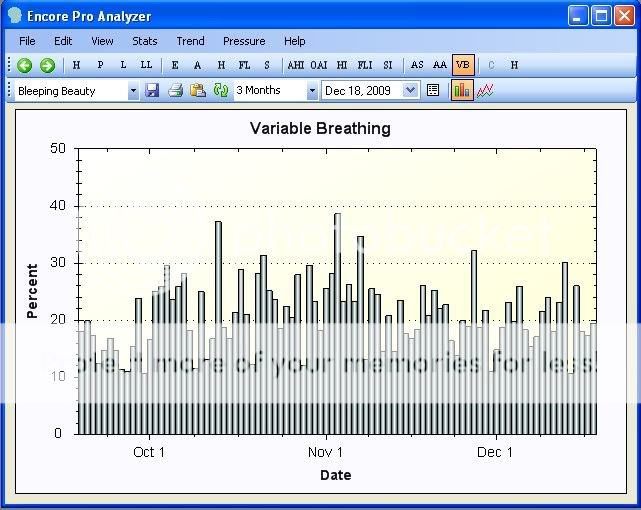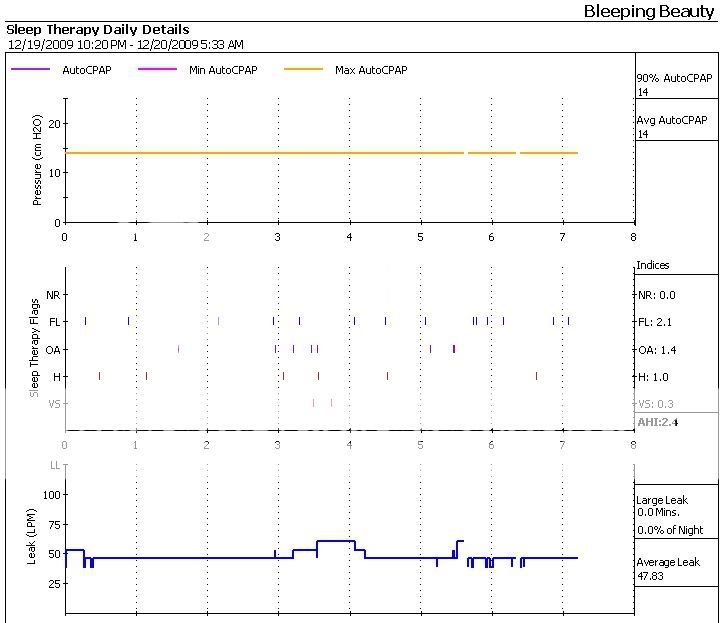Hi, Hawthorne. Unless I read my mask's flow chart incorrectly, the leak rate for this pressure range should be from 42-48 LPM. So I think the leak rate is good. Last night produced the most erratic leak line so far in my APAP experiments, and I don't like seeing that, but the numbers are still reasonable.Hawthorne wrote:Well, your first night you spent more time at the lower pressures (12-13). The leak rate began to be a bit high.
These results are a good representation of what confuses me about APAP data. If you compare one night to another, they're very different, and conclusions are difficult to draw. The first night, I spent most of the time at the lower pressures; the next night, I spent most of the time at the higher pressures; and the third night, I spent virtually the whole night at the peak pressure. Events happen whenever.The second night the majority of the night was spent at 14-15.
The third night again you spent the majority of the night at 14-15. Vs went a little crazy but only at 12-13. All events happened at 14-15. Pattern emerging? - maybe.
Do I need even more pressure? Or could it be that higher pressures may be inducing events? Beats me. The leak doesn't appear to influence anything.
Overall, my numbers are better. But I don't feel like I'm sleeping as soundly as I was at a fixed pressure. I've satisfied my curiosity that APAP is, at least, tolerable (with a small range, anyway), but I've determined that I don't want to run in APAP mode all the time. I much prefer the deeper sleep I seem to get at a fixed pressure, even if my numbers aren't so good.
That sounds reasonable. I think I need a week or two at fixed pressure before I try Auto mode again. I tried a fixed-pressure trial at 13cm several weeks ago, but the results were quite mixed. Perhaps I'll try 14 for awhile and see how that goes.The leak rate is beginning to get a bit higher as you spend more time at the higher pressures, it appears.
I don't know but it appears that you MAY need higher pressures, either a higher but still narrow, range or a fixed cpap pressure. 14 and 15 seems to be emerging as your best pressures but cause more leaks.
Maybe the leaks are disturbing your sleep and spending some time ( 3-4 nights) at a fixed pressure of 14 or 15 may allow you to get control of the leaks better early in the night and not disturb your sleep as much. Then you might try a range again in auto, narrow but higher than 12 - 15.
Thanks, Hawthorne. As always, your input is appreciated.I'm just thinking out loud on this now and trying to think what I would do!
I read something recently (don't ask me where) about ASV being pretty much a necessity when the PB percentage is 20% or more. Mine is quite often over 20%. Here's my PB data for the past three months:-SWS wrote:Bear in mind the many underlying subtleties in sleep-related physiology that you can't manage to measure with your APAP data set...BleepingBeauty wrote:When all is said and done, I think I'll be best served with a fixed pressure (once I figure out what it should be), because I find I'm much more "aware" of my diminished sleep quality with a pressure range.
As one example, CROWPAT, who also has a history of periodic breathing, had one of his worst nights of sleep with THIS clinically acceptable AHI of 4.0. That sleep session's 7% periodic breathing rate made him sleep and feel "rotten" the following day. And yet, the rest of his data doesn't look all that dissimilar to your data above, BB.

Where I am at the moment:This is not at all news to you, BB.... But my opinion of complex SDB physiology in relation to APAP modality: almost never a great match. BiLevel can be better or worse, CPAP is usually better, and ASV tends to yield improved outcomes as well.
I'm going to experiment with different fixed pressures (14cm for now, 15 if need be after a little time adjusting to 14). If my results aren't any more conclusive than my APAP trials have been, I'm going to seek the opinion of Sleep Doc #3 and see if I can get my hands on an ASV machine for a couple of weeks (or have yet another sleep study done with ASV this time if he thinks that's necessary and/or more prudent).
Thanks, -SWS! (And no argument there!)But I have learned by watching your experiments... So many thanks for posting those in detail! Good luck on the remainder of your current APAP pressure-range trials and good luck on your upcoming fixed-pressure experiments as well! That you have finally been able to perform these xPAP comparisons, to your own very clear benefit, is vastly better than your first year of "being kept in the dark" CPAP therapy.















